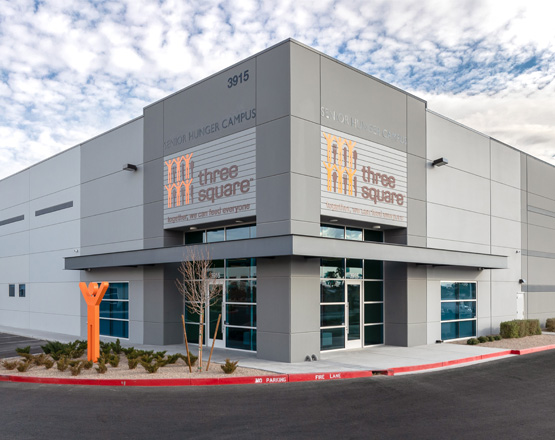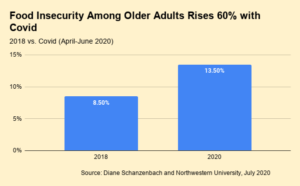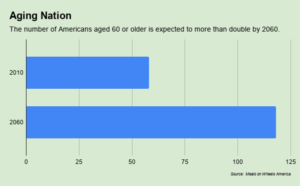The level of food insecurity among seniors has barely budged in recent years, giving greater motivation to food banks that are making targeted efforts to serve this population.
Out of the 78 million people in the U.S. who are 60 or older, 5.5 million of them were food insecure in 2021 (the most recent year for which data is available), according to a recent report from Feeding America. In contrast to other demographics, seniors are experiencing a slight uptick in food insecurity, from 6.8% in 2020 to 7.1% in 2021. That’s up from a pre-Great Recession rate of 6.3% in 2007.
“I think one thing that is surprising is that for seniors, we’re not seeing the same improvements that we’re seeing for the overall population,” said Emily Engelhard, Vice President of Research and Translation for Feeding America. “It suggests that something is going on with seniors that they’re not improving in the same ways that the rest of the population has over the course of the pandemic.”
These rates only get worse when looking at minority senior populations. Black seniors were 3.8 times more likely and Latino seniors three times more likely to have food insecurity than white seniors. Minority seniors also fared poorly compared to the general food-insecure population, in which Blacks were 2.9 times more likely and Latinos 2.5 times more likely to have food insecurity than whites.
Given the entrenched nature of senior food insecurity, food banks are stepping up their efforts to serve seniors.
In 2020, Three Square Food Bank, serving Southern Nevada, dedicated an entire building to addressing senior hunger. This building, known as the Senior Hunger Campus, houses food specifically tailored to seniors and their dietary needs, helping the food bank to meet growing demand.
Three Square’s Golden Groceries program (Food Bank News wrote about it here) serves food from the campus at 37 different locations across Southern Nevada. For seniors who are unable to travel to one of these locations, Three Square has partnered with DoorDash’s Project DASH to deliver food to their homes, as well as Lyft’s Grocery Access Program to help seniors without transportation get to and from Golden Groceries locations.
According to Alyx Phillips, Director of Grants Administration at Three Square, a key element of all the programs is providing a dignified experience. “I would say with senior hunger there are a lot of pride and shame issues. It can be difficult to offer help,” she said. “So whenever we build any of our programs, we really make sure that it’s a respectful, dignified experience where it doesn’t feel like a handout. It feels like they’re just going to a pantry to have a wonderful experience.”
Central Texas Food Bank also emphasized the need to treat seniors with respect and make sure they feel that they have agency. In partnership with Feeding Texas and Meals on Wheels and More, the food bank recently compiled a Senior SNAP Outreach Toolkit based on learnings from a year-long project in which more than 200 seniors in Central Texas were assisted with benefit applications and surveyed on their experience.
The toolkit specifically highlights best practices around signing seniors up for SNAP. While outreach visits to senior centers or community events are worthwhile and can build word-of-mouth recognition, Central Texas Food Bank found that building a robust referral network was also critical.
Creating partnerships with senior-serving agencies and entrusting them to identify and refer potential applicants was deemed a key strategy. “The most effective and successful referral partnerships involve streamlined channels of communication with staff of the senior-serving agency,” the report noted. The food bank also found home visits to be very effective, but cautioned that such visits should be done along with a partner organization (such as Meals on Wheels) that seniors already know and trust.
The question of whether to distribute food to seniors at home or in community settings remains an ongoing debate. While many seniors face mobility or transportation issues, they also stand to benefit from the socialization that comes with getting out of the house, given the isolation and loneliness that many face.
Community Food Share, a Colo.-based food bank, recently received a grant from the Gretchen Swanson Center for Nutrition that could help it explore aspects of this issue. The food bank’s Elder Share program provides free groceries to adults aged 60 or over, twice a month. As of 2023, Elder Share had distributed over 270,000 meals to seniors in need.
The Rooted in Evidence grant from Gretchen Swanson will allow the food bank to explore which food distribution methods support better nutritional outcomes for seniors. “Our research question is: does in-person shopping have equal or better nutritional outcomes for older adults compared to food delivery boxes?” said Abbey Fluckiger, Community Centered Research Analyst, in a recent video.
According to Fluckiger, Community Food Share is in the process of selecting senior living facilities to test-drive a program that will transport otherwise immobile seniors from their home to an Elder Share location. Elder Share is not always able to adequately serve seniors who have issues with transportation, the food bank has found. In addition, a mobile food pantry set up in senior living facilities cannot always meet particular nutritional needs because of its limited inventory compared to the main facility.
While the project is still in its early stages, Community Food Share hopes that a combination of program testing and feedback from seniors will reshape senior food insecurity in the area. “We’re just going to run a pilot for a year and see – do people want to get on the bus and ride over to the pantry?” said Fluckiger. “Is it something that people take advantage of, or is the convenience of just having food come to your house more appealing?”
With the U.S. senior population expected to grow to 104 million by 2050, any progress food banks can make on narrowing senior food insecurity is welcome. According to Feeding America, if the current rate of food insecurity does not improve, then seven million seniors could be food insecure by 2050. – Nicolas Magrino
Nicolas Magrino is a graduate student at the Craig Newmark Graduate School of Journalism at CUNY and a summer intern at Food Bank News.
PHOTO, ABOVE: The Senior Hunger Campus at Three Square Food Bank.
Like what you’re reading?
Support Food Bank News









